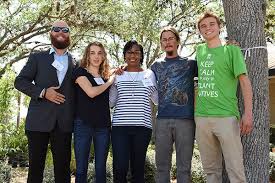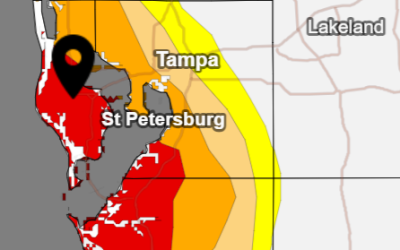Living on the coast of Florida offers numerous advantages, from breathtaking ocean views to a mild climate. However, coastal living also comes with its fair share of challenges, particularly when it comes to weathering hurricanes and tropical storms. To enhance coastal resilience and protect your property from the wrath of Mother Nature, consider planting native salt-tolerant plants. In this blog post, we’ll explore the benefits of these hardy plants and why they are a smart choice for coastal homeowners.
The Importance of Native Plants
Native plants are species that have evolved in a particular region over time, adapting to the local climate and conditions. They are an essential component of the ecosystem, providing food and habitat for native wildlife. When you choose to plant native species in your coastal landscape, you help preserve the natural balance of the local ecosystem while reaping a host of benefits for your property.
Why Salt-Tolerant Plants?
- Resilience Against Saltwater Intrusion: Coastal areas are susceptible to saltwater intrusion, which can harm conventional plants. Salt-tolerant plants, as the name suggests, can withstand exposure to saltwater inundation and thrive in salty soils. This resilience is especially valuable during hurricanes when storm surges bring sea water inland.
- Erosion Control: The robust root systems of salt-tolerant plants help stabilize the soil and prevent erosion. Hurricanes often bring heavy rainfall and strong winds that can strip away topsoil, but native salt-tolerant vegetation acts as a natural buffer against these forces.
- Low Maintenance: Native plants are well-suited to the local climate, reducing the need for excessive watering and fertilization once established. They are adapted to periods of drought, so they are low-maintenance choices for homeowners.
- Habitat for Wildlife: Salt-tolerant plants attract native wildlife, such as birds, butterflies, and pollinators. By creating a haven for these species, you contribute to the overall health of the ecosystem.
Popular Salt-Tolerant Florida Natives
Seaside Goldenrod
Seaside Goldenrod, Solidago sempervirens, is a perennial wildflower that grows 3-6 ft. in height. Small, yellow flowers are arranged along the upper side of branches, forming a feathery, plume-shaped inflorescence in summer and fall. Pollinators visit this showy flowering wildflower heavily! Goldenrod is very easy growing, salt tolerant, as well as tolerant of wet to dry soil. Plant in a background setting with full sun. To prevent excessive seeding, cut the seed heads off after blooming has wrapped up. Shop Seaside Goldenrod here.
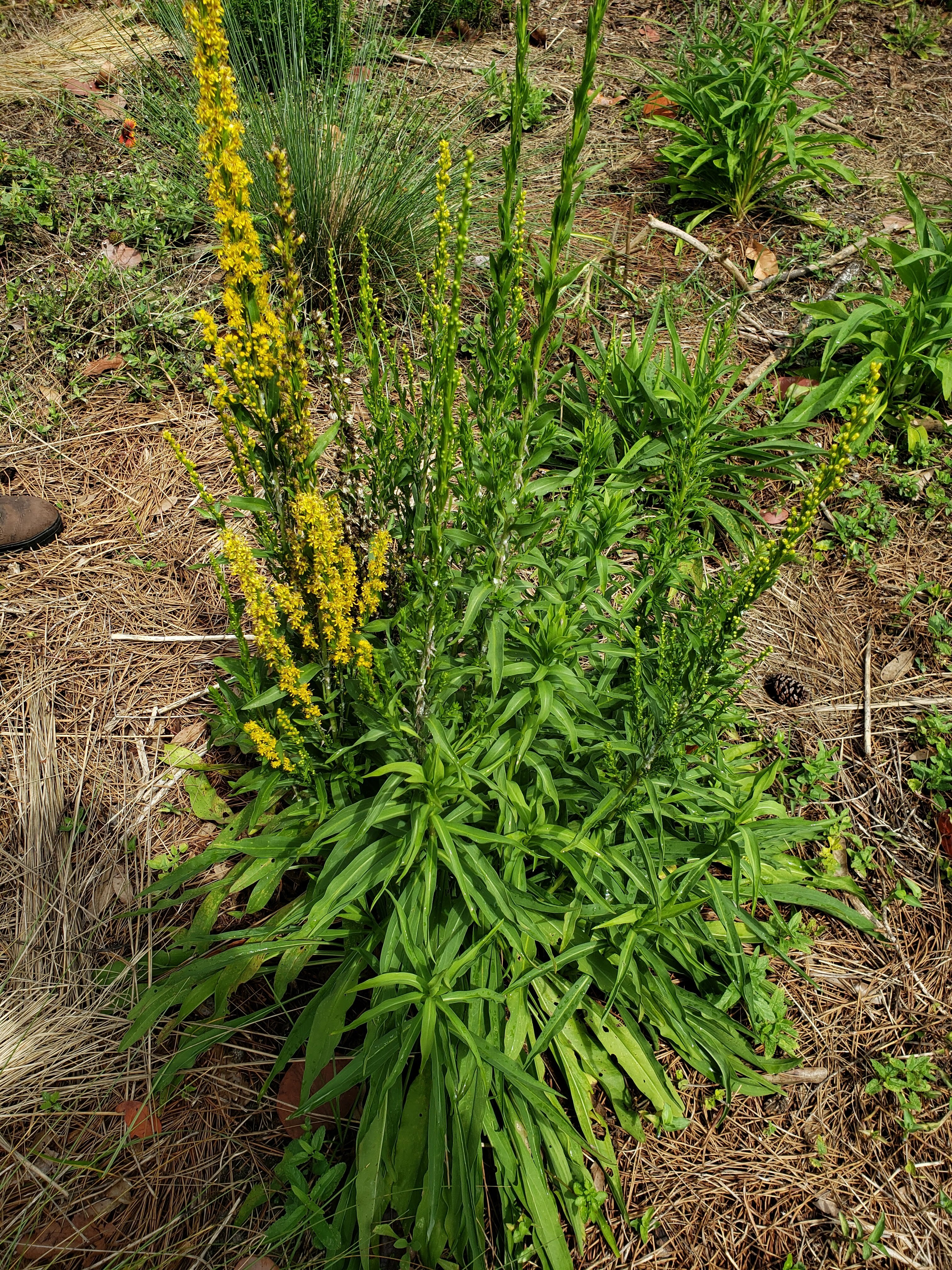
Red- Tip and Horizontal Cocoplum
Red-tip Cocoplum, Chrysobalanus icaco, can quickly grow into a large bush or small tree growing up to 20 feet. Its foliage is nearly round, shiny, dark-green, leathery and very ornamental with the new growth tips displaying a bronze-red coloring. The fruit are edible, dark purple plum-like fruit. Red-tip Cocoplum will grow in full sun to shade and it becomes very drought tolerant after establishment. Cocoplum can be very frost sensitive. They take pruning well and are easy to grow as a popular and widely used native ornamental. It is the larval host for Epicorsia moths. Shop Red- Top Cocoplum here.
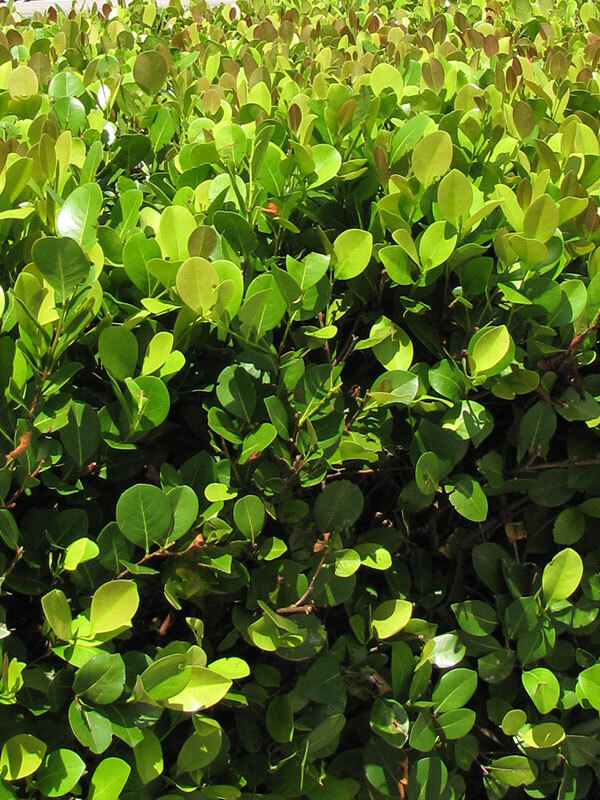
Horizontal Cocoplum is an evergreen shrub with low, broad or horizontal growth. This plant can still grow to 6-8 feet high, but can be reasonably maintained at between knee and waist height. Be sure to leave this plant plenty of room for its 5-6 foot spread. The flowers are small cream-colored blooms that are not particularly noticeable in late spring. The white with pink blush fruit is edible and attractive on the plant. Tolerant of full sun to shade and are drought, salt, wind, and poor soil tolerant. They are also a larval host for Epicorsia moths. Shop Horizontal Cocoplum here.
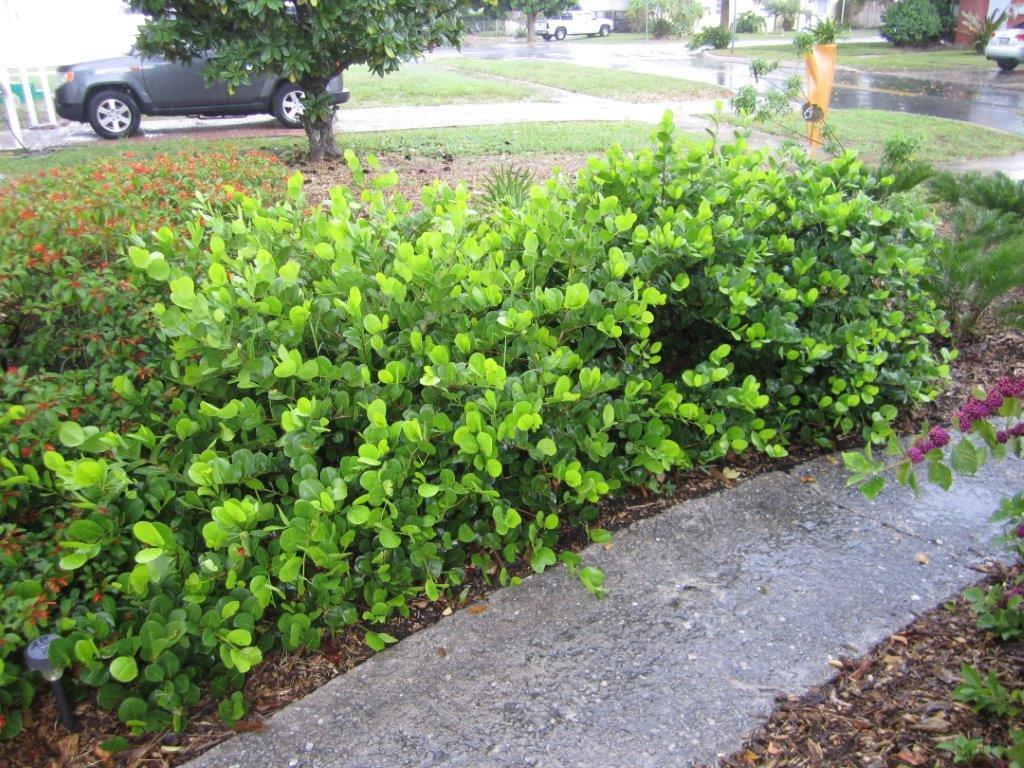
Cabbage Palm
Cabbage Palm, Sabal palmetto, is the honorable state tree of Florida as well as a monarch palm tree for exuding a sense of place in Florida landscapes! Fan shaped leaves can create a spherical shaped head on mature palms that are not pruned. White flowers are numerous followed by shiny, black fruits. It supports many epiphytic plants and this palm is a wildlife bonanza supporting pollinators, birds, and mammals. Additionally, it has a rich ethnobotanical history. Cabbage Palm is very wind, salt, drought, and flood tolerant. Unfortunately, many of the Cabbage Palms that are in suburban landscapes, especially commercial properties, are terribly over pruned. This cancerous cultural habit is ugly and damages the well being of the palm and reduces its ecological services. If Cabbage Palm has to be pruned, it should never be pruned with the leaves cut past a horizontal plain at the bottom set of the leaves. Shop Cabbage Palm here.

Sea Grape
Sea Grape, Coccoloba uvifera, is variable, but can reach up to 35 to 40 ft. in height. It is an evergreen shrub or tree with nearly round, large red-veined leaves. They produce spikes of whitish flowers; and edible, reddish fruits which hang in grape-like clusters on female plants. This is an iconic large shrub or tree from coastal settings. Leaves turn bronze to red in the winter. Plant Sea Grape in well drained soil in full sun to partial sun. It can be used as a specimen plant or tree and hedging. It is great for high wind and salt exposed beach front or other coastal exposed locations. The leaf is large and can create a great deal of debris, so plant it where this will not become a problem. Shop Sea Grape here.
Sea Purslane
Sea Purslane, Sesuvium portulacastrum, is a native that occurs widely throughout the globe in warm coastal areas and is an important erosion control plant. It is a succulent that is very adaptable, but it comes from locations that are moist and regularly inundated with salt water. It does not have to be washed in salt water in cultivation, but it is a great ground cover for coastal landscapes. The thick foliage is dark green on rubbery stems. The small pink flowers are produced sporadically year round. Its foliage is used as an edible. Shop Sea Purslane here.
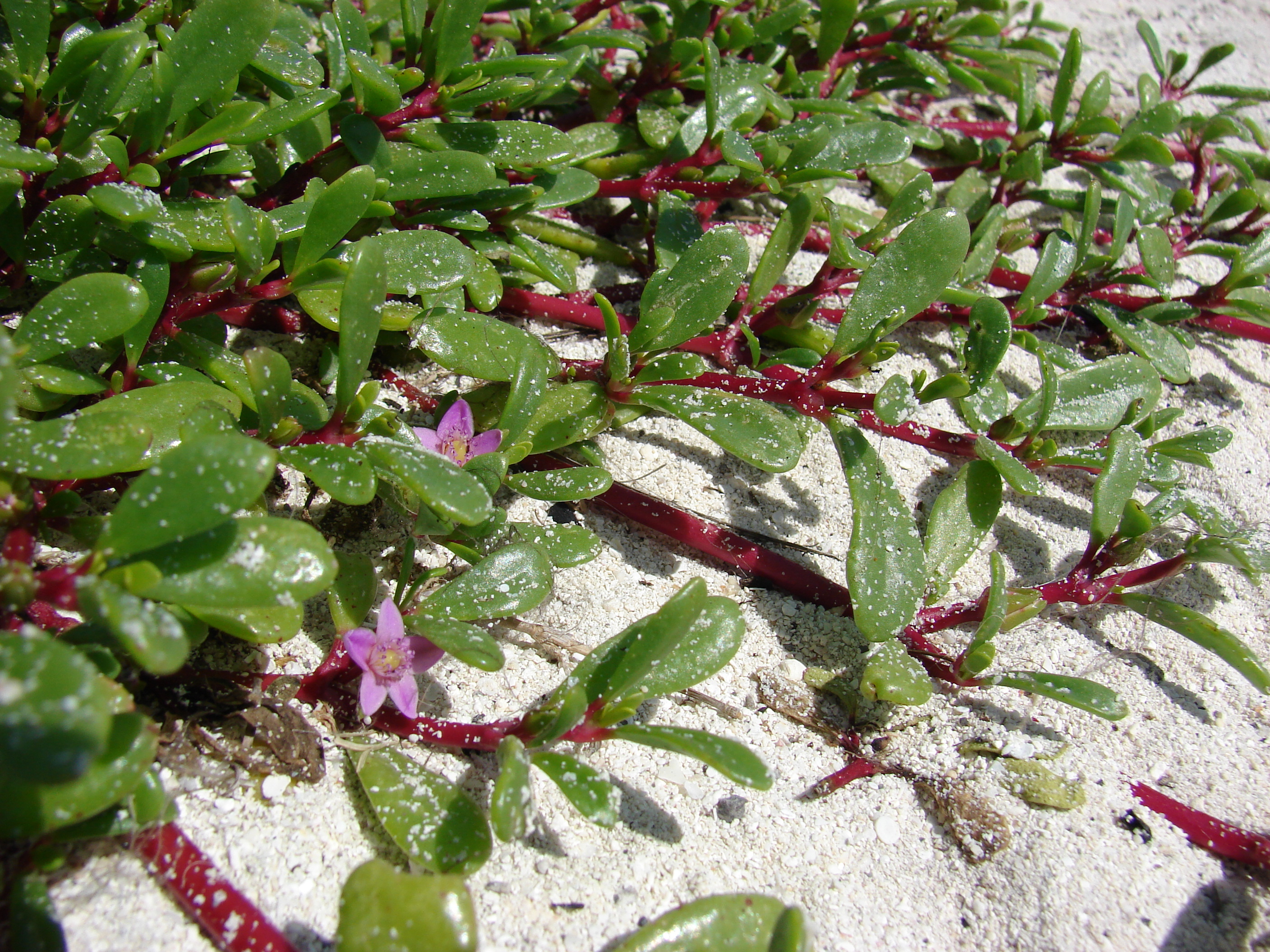
Silver and Green Buttonwood
Silver Buttonwood, Conocarpus erectus var. sericeus, typically will grow to 15-25 feet in height, sometimes larger. It is a medium tree or large shrub with an open to dense crown with pruning. Its leaves are alternate, 2-4 inches long, leathery, and covered with silvery hairs. Flowers are green ‘button-like’ clusters on the branch tips and the cone-like fruit are made of many small dry seeds. It requires full sun and is used as an accent, hedge, screening plant, or specimen tree in residential and commercial landscapes along the coast. Buttonwoods are the ‘fourth’ Mangrove and as such, are highly wind and salt tolerant, including inundation tolerance for front line water front landscapes. This is a very popular native for its colorful ornamental foliage. Shop Silver Buttonwood here.

Green Buttonwood, Conocarpus erectus, is a large broadleaf evergreen shrub or medium size tree naturally occurring in coastal settings and is considered the 4th Mangrove in the Mangrove complex. It has high wind and salt tolerance. This species can be low and spreading with twisted limbs, or trained into an upright multiple trunk or single trunk tree up to 40 feet in height. It can also be used as a screening or enclosure shrub too. Small creamy white flowers precede dry seeds that are clustered to give it the appearance of coat buttons. This is an evergreen tree that fits most properties and is very adapted to high wind, salt, drought, or inundation with salt water in nearly frost free areas. Shop Green Buttonwood Here.
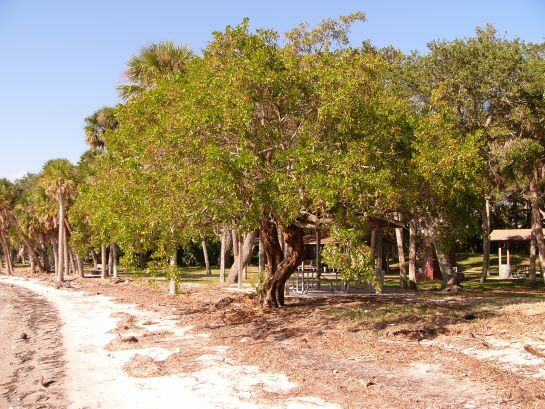
Hurricane Preparedness with Native Salt-Tolerant Plants
When planting salt-tolerant natives for hurricane preparedness, consider the following tips:
- Use a Variety of Species: Diversify your landscape with a mix of salt-tolerant plants to increase resilience. A variety of species will provide more robust protection against extreme weather conditions.
- Proper Placement: Plant salt-tolerant vegetation strategically along your property to create natural windbreaks and buffers against storm surges.
- Regular Maintenance: While native plants are low-maintenance, periodic pruning and upkeep ensure they continue to thrive and provide optimal protection.
Conclusion
Planting native salt-tolerant plants in your coastal Florida landscape is a win-win. You enhance the resilience of your property against hurricanes, contribute to the local ecosystem, and enjoy the beauty of these hardy, low-maintenance plants. By choosing these native species, you not only protect your home and reduce storm damage in the landscape, but also play a vital role in preserving Florida’s unique coastal habitats.



